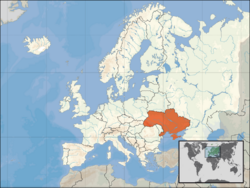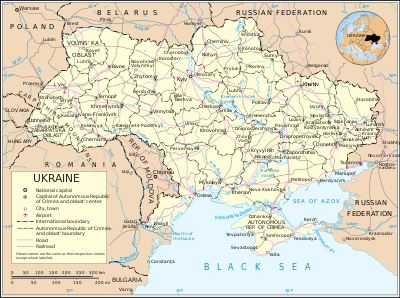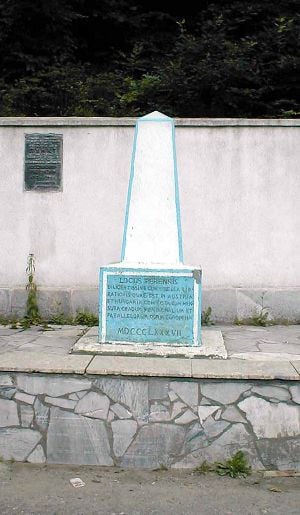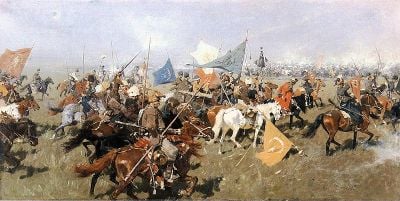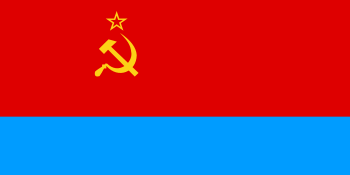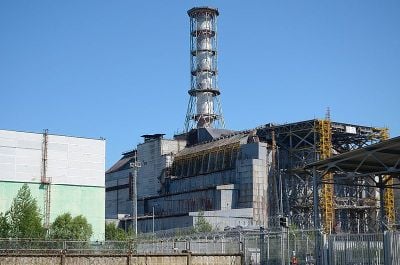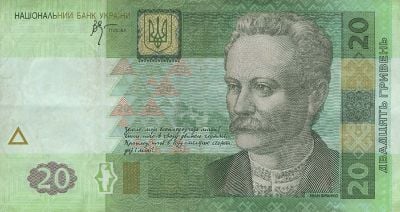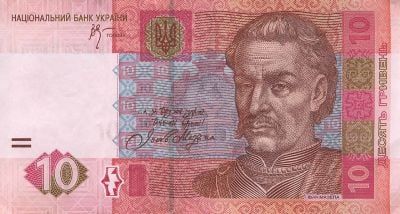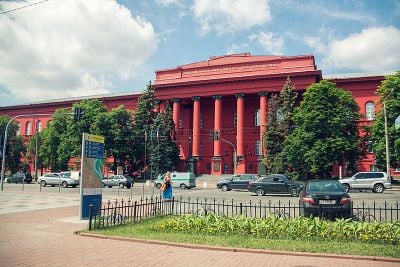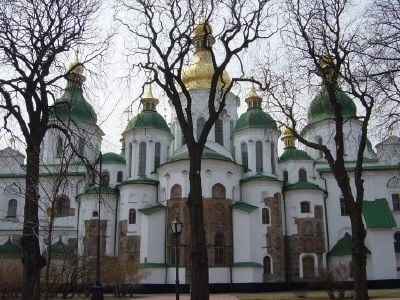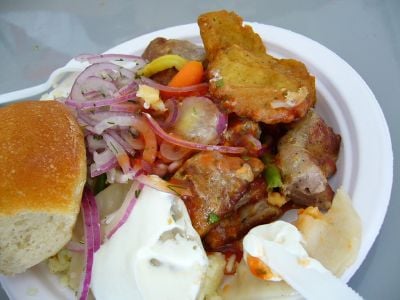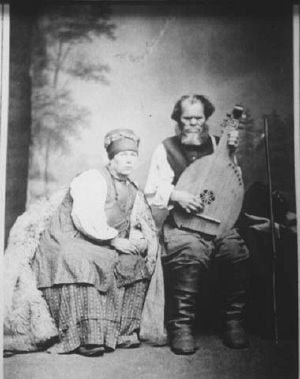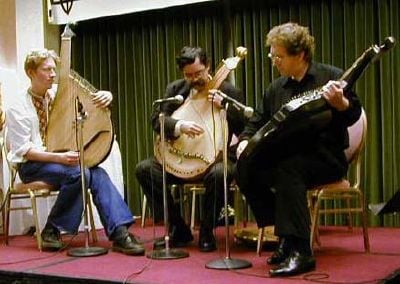Ukraine
| –£–ļ—Ä–į—ó–Ĺ–į Ukraine |
||||||
|---|---|---|---|---|---|---|
|
||||||
| Anthem:  Shche ne vmerla Ukrayiny (transliteration) Ukraine's glory has not perished |
||||||
| |
||||||
| Capital (and largest city) | Kyiv 50¬į27‚Ä≤N 30¬į30‚Ä≤E | |||||
| Official languages | Ukrainian | |||||
| Recognized regional languages | Russian, Crimean Tatar | |||||
| Ethnic groups (2001) | 77.8% Ukrainians, 17.3% Russians, 4.9% others and unspecified[1] |
|||||
| Demonym | Ukrainian | |||||
| Government | Unitary semi-presidential republic | |||||
|  -  | President | Volodymyr Zelenskyy | ||||
|  -  | Prime Minister | Denys Shmyhal | ||||
|  -  | Chairman of Parliament | Ruslan Stefanchuk | ||||
| Legislature | Verkhovna Rada | |||||
| Formation | ||||||
|  -  | Kievan Rus' | 882  | ||||
| ¬†-¬† | Kingdom of Galicia‚ÄďVolhynia | 1199¬† | ||||
|  -  | Cossack Hetmanate | 1649  | ||||
|  -  | Ukrainian National Republic | November 7, 1917  | ||||
|  -  | West Ukrainian National Republic | November 1, 1918  | ||||
|  -  | Ukrainian SSR | December 30, 1922  | ||||
|  -  | Second Declaration of Independence | June 30, 1941  | ||||
|  -  | Independence from the Soviet Union | August 24, 19911  | ||||
| Area | ||||||
|  -  | Total | 603,628 km² (46th) 233,090 sq mi  |
||||
|  -  | Water (%) | 7% | ||||
| Population | ||||||
|  -  | January 2022 estimate | (excluding Crimea) (36th) |
||||
|  -  | 2001 census | 48,457,102[1]  | ||||
|  -  | Density | 73.8/km² (115th) 191/sq mi |
||||
| GDP (PPP) | 2022 estimate | |||||
|  -  | Total | |||||
|  -  | Per capita | |||||
| GDP (nominal) | 2022 estimate | |||||
|  -  | Total | |||||
|  -  | Per capita | |||||
| Gini (2019) | 26.6[4]  | |||||
| Currency | Hryvnia (UAH) |
|||||
| Time zone | Eastern European Time (UTC+2) | |||||
|  -  | Summer (DST) | Eastern European Summer Time (UTC+3) | ||||
| Internet TLD | .ua, .—É–ļ—Ä | |||||
| Calling code | [[+380]] | |||||
| 1 An independence referendum was held on December 1, after which Ukrainian independence was finalized on December 26. The current constitution was adopted on June 28, 1996. | ||||||
Ukraine is a country in Eastern Europe, formerly a part of the Soviet Union, bordering Russia, Romania and the Black Sea.
From at least the ninth century, the territory of present-day Ukraine was a center of medieval East Slavic civilization forming the state of Kievan Rus. After a brief period of independence (1917‚Äď1921) following the Russian Revolution of 1917, Ukraine became one of the founding Republics of the Soviet Union in 1922. Ukraine and became independent again after the Soviet Union's collapse in 1991.
The Second World War and German occupation in Ukraine left total civilian losses estimated between five and eight million, including over half a million Jews killed by the Einsatzgruppen, sometimes with the help of local collaborators.
Ukraine's culture has unique art, architecture, cuisine, dance, literature, music, theater, and cinema, all shaped by various eras of domination by other nations, Soviet repression, and an on-going striving for national identity.
Geography
The Ukrainian word Ukrayina stems from the Old Slavic root kraj, meaning "edge" or "borderland," and krayina means "country." In English, the country is sometimes referred to as the Ukraine, similar to the Netherlands, or the Congo. However, usage without the article is now more frequent, especially since the country's independence.
Ukraine has a strategic position in Eastern Europe, bordering the Black Sea and Sea of Azov in the south, Poland, Slovakia and Hungary in the west, Belarus in the north, Moldova and Romania in the south-west and Russia in the east. Some claim the geographical center of Europe is near the small town of Rakhiv, in western Ukraine.
With an area of 233,074 square miles (603,700 square kilometers), Ukraine is the second largest country in Europe (after the European part of Russia), and slightly smaller than Texas.
The Ukrainian landscape consists of the Polissya and Volyn northern forests, the central forest steppes, the Donetsk eastern uplands, which are up to 1600 feet (500 meters) above sea level, and the coastal lowlands and steppes along the Black and Azov seas. The Carpathian Mountains in the west reach 6760 feet (2061 meters) at Mount Hoverla. Roman-Kosh in the Crimean peninsula reaches 5061 feet (1543 meters.) Alpine meadows are another interesting feature.
Ukraine has a mostly temperate continental climate, with a more Mediterranean climate on the southern Crimean coast. The average temperature in January (winter) is 26¬įF (-3¬įC) in the southwest and 18¬įF (-8¬įC) in the northeast. The average in July (summer) is 73¬įF (23¬įC) in the southeast and 64¬įF (18¬įC) in the northwest.
Precipitation is highest in the west and north. Winters vary from cool along the Black Sea to cold farther inland. Summers are warm across the greater part of the country, but generally hot in the south.
The main rivers flow northwest to southeast to empty into the Black Sea and Sea of Azov. The Dnieper River is the longest, with hydroelectric dams, reservoirs, and numerous tributaries, dominating central Ukraine. The Southern Bug with its tributary, the Inhul, flows into the Black Sea. To the west and southwest is the Dniester. The middle course of the Donets, a tributary of the Don, flows through the south-east. To the southwest the delta of the Danube forms the border with Romania.
Three zones of vegetation appear from north to south: the Polissya (woodland and marsh), the forest-steppe, and the Steppe. The Polissya zone has oak, elm, birch, hornbeam, ash, maple, pine, linden, alder, poplar, willow, and beech. In mountainous areas, the lower slopes are covered with mixed forests, the intermediate slopes have pine forests, with alpine meadows at higher altitudes.
Ukraine’s fauna is diverse. Predators include the wolf, fox, wildcat, and marten, and hoofed animals include the roe deer, wild pig, elk and mouflon (a wild sheep). Rodents include gophers, hamsters, jerboas, and field mice. Birds include black and hazel grouse, owl, gull, and partridge, as well as wild goose, duck, and stork. Fish include pike, carp, bream, perch, sturgeon, and sterlet.
Natural resources comprise iron ore, coal, manganese, natural gas, oil, salt, sulfur, graphite, titanium, magnesium, kaolin, nickel, mercury, timber, and arable land. The country has significant environmental problems, especially those resulting from the Chernobyl nuclear power plant disaster in 1986, and subsequent radiation contamination in the northeast. Other issues include inadequate supplies of potable water, air and water pollution, and deforestation. Conservation of natural resources is a stated high priority, although implementation suffers from a lack of financial resources.
The historic city of Kiev is the capital and the largest city, and is located in the north central part of the country on the Dnieper river. In 2005 Kiev had 2,660,401 inhabitants, and this figure continues to grow. Kiev is an important industrial, scientific, educational and cultural center of Eastern Europe. It is home to many high-tech industries, higher education institutions and world-famous historical landmarks. The city has an extensive infrastructure and highly developed system of public transport, including the Kiev Metro.
History
Chalcolithic (Copper Age) people populated what became western Ukraine, and the Sredny Stog culture (4500-3500 B.C.E.) was situated north of the Sea of Azov. The early Bronze Age Yamna culture (3600-2300 B.C.E.) occupied the Bug-Dniester-Ural region, leaving hundreds of crude stone stela, followed by the Catacomb culture in the third millennium B.C.E.
During the Iron Age, these were followed by the Cimmerians, Scythians, Sarmatians, among other pastoral nomads, along with ancient Greek colonies founded from the sixth century B.C.E. on the north-eastern shore of the Black Sea, and the colonies of Tyras, Olbia, Hermonassa, perpetuated by Roman and Byzantine cities until the sixth century C.E.
In the third century C.E., the Goths arrived in the lands of Ukraine, which they called Oium, named by archaeologists the Chernyakhov culture. The Ostrogoths stayed in the area but came under the sway of the Huns from the 370s.
Kiev culture
To the north, the Kiev culture flourished from the third to fifth centuries C.E. It is considered to be the first Slavic archaeological culture, and was contemporaneous to (and located mostly just to the north of) the multi-ethnic Gothic kingdom, Oium. Settlements are found mostly along river banks, frequently either on high cliffs or right by the edge of rivers. The dwellings are semi-subterranean, often square (about four by four meters), with an open hearth in a corner. Most villages consist of just a handful of dwellings.
The Huns were defeated at the battle of Nedao in 454. With the power vacuum created with the end of Hunnic and Gothic rule, Slavic tribes, possibly emerging from the remnants of the Kiev culture, began to expand over much of what is now Ukraine during the fifth century, and beyond to the Balkans from the sixth century.
In the seventh century, the territory of modern Ukraine was the core of the state of the Bulgars (often referred to as Old Great Bulgaria) who had their capital in the city of Phanagoria. The majority of the Bulgar tribes migrated in several directions at the end of the seventh century and the remains of their state was swept by the Khazars, a semi-nomadic people from Central Asia. The Khazars founded the independent Khazar kingdom near the Caspian Sea and the Caucasus, which included territory in what is now eastern Ukraine, Azerbaijan, southern Russia, and Crimea.
Golden Age of Kiev
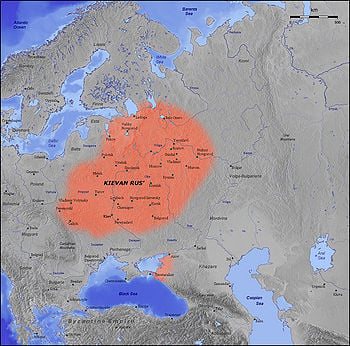
Rus is mentioned for the first time by European chroniclers in 839 C.E. Kievan Rus' comprised several principalities ruled by the interrelated Rurikid princes. The Kievan state flourished from the ninth to the eleventh centuries under the rulers Volodymyr I (980-1015), his son Yaroslav I the Wise (1019-1054), and Volodymyr Monomakh (1113-1125). Volodymyr I Christianized Rus in 988 C.E., while the other two gave it a legal code. Christianity brought the alphabet, developed by the Macedonian saints Cyril and Methodius.
This state laid the foundation for the national identity of Ukrainians, as well as other East Slavic nations. Its capital was Kiev, wrestled from Khazars by Askold and Dir in about 860. The Kievan Rus' elite initially consisted of Varangians from Scandinavia who later became assimilated into the local Slavic population and gave the Rus' its first powerful dynasty, the Rurik Dynasty.
With the death of Mstislav of Kiev (1125‚Äď1132) Kievan Rus' disintegrated into the separate principalities. The thirteenth century Mongol invasion dealt Rus' a final blow.
Mongols, Lithuanians and Poles
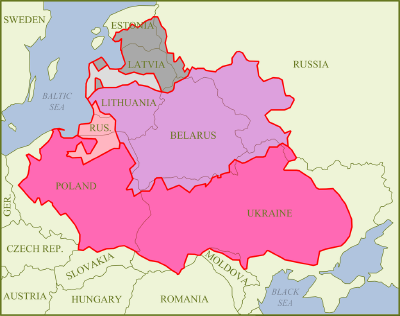
The principalities of Halych and Volhyniamerged into the state of Halych-Volynia, and resisted the Mongols and Tatars to become a Rus bastion through the fourteenth century. A distinguished ruler was Danylo Romanovich (1201-1264), crowned by Pope Innocent IV in 1264, the only Ukrainian king to be thus crowned.
After the fourteenth century, Rus fell under foreign domination. Lithuania controlled most of the Ukraine lands except for Halych and Volhynia, defeated by Poland. The Golden Horde, an outpost of Genghis Khan's empire, controlled the southern steppes and the Black Sea coast. The Crimean khanate, an Ottoman vassal state, succeeded the Golden Horde from 1475.
Eventually, the Grand Duchy of Lithuania controlled north-west and central Ukraine. The Grand Duchy adopted the Rus administration and the legal system, while the state language was Old Slavonic, including a great deal of vernacular Ukrainian and Belorussian. From 1386, after a dynastic link with Poland, the Lithuanian elite adopted Roman Catholicism as well as Polish language and customs, while the common people retained allegiance to the Eastern Orthodox Church, increasing social tensions.
By the 1569 Union of Lublin, that formed the Polish-Lithuanian Commonwealth, a significant part of Ukrainian territory was transferred to the Polish rule. The 1596 Brest-Litovsk Union divided Ukrainians into Orthodox and Uniate Catholics. Sigismund III Vasa attempted to bring the Orthodox population under the Catholicism through creation of the Ukrainian Greek Catholic Church. While the upper class increasingly turned to Catholicism, the Ukrainian commoners, deprived of their native protectors among Ruthenian nobility, turned for protection to the Cossacks who remained fiercely Orthodox.
From 1569 the Polish-Lithuanian Commonwealth sustained a series of Tatar invasions. The borderland area to the south-east was in a state of semi-permanent warfare until the eighteenth century. More than three million people, predominantly Ukrainians but also Circassians, Russians, Belarusians and Poles, were captured and enslaved during the time of the Crimean Khanate.
The Cossacks
In the middle of the seventeenth century, a Cossack state, the Zaporozhian Sich, was established by Dnieper Cossacks and the Ruthenian peasants fleeing Polish serfdom. Zaporozhian Cossacks, who were based on an island fortress below the Dnipro River rapids, became symbols of Ukrainian national identity.
Strife between Ukrainians and their Polish overlords, over the exploitation of peasants and suppression of the Orthodox Church, began in the 1590s, spearheaded by the Cossacks. In 1648, Bohdan Khmelnytsky led the largest of the Cossack uprisings] against the Commonwealth and the Polish king John II Casimir. This uprising finally led to a partition of Ukraine between Poland and Russia. Khmelnytsky sought help against the Poles in a treaty with Moscow in 1654. The Muscovites used as a pretext for occupation. Left-Bank Ukraine was eventually integrated into Russia as the Cossack Hetmanate.
The hetmanate reached its pinnacle under Ivan Mazepa (1687‚Äď1709). Literature, art, architecture (in Cossack baroque style), and learning flourished. Mazepa sought a united Ukrainian state, under the tsar's sovereignty. When Tsar Peter threatened Ukrainian autonomy, Mazepa allied with Charles XII of Sweden and rose against him, to be defeated in the Battle of Poltava in 1709.
Russian domination
By the end of the eighteenth century, Western Ukrainian Galicia was taken over by Austria, while the rest of Ukraine was progressively incorporated into the Russian Empire. Empress Catherine II extended serfdom to the traditionally free Cossack regions and destroyed the Zaporozhian Sich in 1775. Russia repressed any movement towards national identity during the nineteenth century. The Ukrainian language was banned from all but domestic use.
However, many Ukrainians accepted their fate in the Russian Empire and some were to achieve a great success there. Many Russian writers, composers, painters and architects of the nineteenth century were of Ukrainian descent, most notably Nikolai Gogol.
World War I
During World War I Austro-Hungarian authorities repressed pro-Russian Ukrainians in Galicia. Over 20,000 supporters of Russia were arrested and placed in an Austrian concentration camp in Talerhof, Styria, and in a fortress at Terezín (now in the Czech Republic). When World War I and the October Revolution in Russia shattered the Austrian and Russian empires, Ukrainians were caught in the middle. Between 1917 and 1918, several separate Ukrainian republics manifested independence, the Tsentral'na Rada, the Hetmanate, the Directorate, the Ukrainian People's Republic and the West Ukrainian People's Republic.
In this time, most resistance against the Austro-Germans and the Red Army was made by the army of Nestor Makhno, who led an Anarchist revolution in this period.
With defeat in the Polish-Ukrainian War and then the failure of the J√≥zef PiŇāsudski's and Symon Petlura's Kiev Offensive, by the end of the Polish-Soviet War after the Peace of Riga in March 1921, the western part of Galicia was incorporated into Poland, and the larger, central and eastern region became the Ukrainian Soviet Socialist Republic.
Despite turbulence, Ukrainian language publications proliferated in this period. The Hetmanate, installed by Germany, bolstered the Ukrainian culture and education.
Early Soviet years
During the early-Soviet years, Ukrainian culture and language enjoyed a revival known as ‚ÄúUkrainization‚ÄĚ became the local version of the Soviet "indigenization" policy.
Ukraine participated in Soviet industrialization, starting from the late 1920s, and the republic's industrial output quadrupled in the 1930s. However, Ukraine's peasantry, a backbone of the nation, paid a heavy price under Stalin's economic policies. To increase food supplies and finance industrialization, Josef Stalin instituted a program of collectivization of agriculture, using regular troops and secret police to combine the peasants' lands and animals into collective farms. Those who resisted were arrested and deported. Production quotas were enforced.
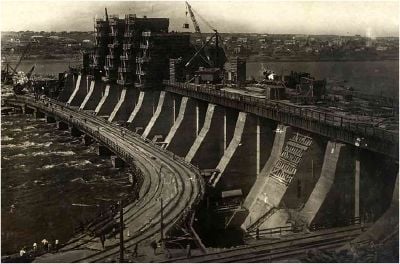
Collectivization devastated agricultural productivity. As collective members were not allowed to receive any grain until the unachievable quotas were met, starvation became widespread. Millions died in what became known as the Holodomor. Since the Soviet government denied the existence of the famine, available data is inconclusive as the exact numbers who died.
The Soviet government attacked the Ukrainian political and cultural elite, accusing them of "nationalist deviations"‚ÄĒa reverse on the former policy of Ukrainization. Two waves of purges (1929‚Äď1934 and 1936‚Äď1938) resulted in the elimination of four fifths of the Ukrainian cultural elite.
World War II
During World War II, some elements of the Ukrainian nationalist underground fought both Nazi and Soviet forces, forming the Ukrainian Insurgent Army in 1942, while other Ukrainians initially collaborated with the Nazis. In 1941 the German invaders and their Axis allies initially advanced against desperate but unsuccessful efforts of the Red Army. In the battle of Kiev, the city was acclaimed by the Soviets as a "Hero City," for the fierce resistance of the Red Army and of the local population. More than 650,000 Soviet males between the ages of 15-50 were taken captive.
Initially, many Ukrainians received the Germans as liberators, especially in western Ukraine, that the Soviets occupied in 1939. However, Nazi administrators of conquered Soviet territories made little attempt to exploit Ukrainian dissatisfaction with Soviet policies. Instead, the Nazis preserved the collective-farm system, carried out genocidal policies against Jews, deported others (mainly Ukrainians) to work in Germany, and began a systematic depopulation of Ukraine to prepare it for German colonization, which included a food blockade on Kiev. Under these circumstances, most people living on the occupied territory opposed the Nazis.
Total civilian losses during the war and German occupation in Ukraine are estimated between five and eight million, including over half a million Jews killed by the Einsatzgruppen, sometimes with the help of local collaborators. Of the estimated 8.6 million Soviet troops who fell in battle against the Nazis, about a quarter (2.7 million) were ethnic Ukrainians. Ukraine is distinguished as one of the first nations to fight the Axis powers in Carpatho-Ukraine, and one that saw some of the greatest bloodshed during the war.
Post-war struggle with Soviet rule
The republic, heavily damaged by the war, sustained a man-made famine in 1946‚Äď1947, when Soviet authorities forcibly confiscated grain crops, ignoring the drought of 1946. Collected grain was distributed to the other regions of Soviet Union, and 2.5 million tons were exported abroad. In Ukraine about one million people, predominantly in rural areas, died from the famine.
In the Western Ukraine, the Ukrainian Insurgent Army, formed in World War II to fight both Soviets and Nazis, continued to fight the USSR into the 1950s. Using guerrilla war tactics, the insurgents assassinated Soviet party leaders, NKVD and military officers. In particular, due to the resistance, the 1946-1947 famine was much less severe in West Ukraine than in other Ukrainian regions.
Following the death of Stalin in 1953, Nikita Khrushchev became the new leader of the USSR. Being the First Secretary of Communist Party of Ukrainian SSR in 1938-1949, Khrushchev played a role in Stalin's repressions, the man-made famine in 1946-1947, and the suppression of resistance in West Ukraine. But after taking the power, he found it best to propagandize the friendship between the Ukrainian and Russian nations. In 1954, the 300th anniversary of the Treaty of Pereyaslav was widely celebrated, and in particular, the Crimea was transferred from the Russian SFSR to the Ukrainian SSR.
In the times of Khrushchev Thaw of 1960s, there were dissident movements in Ukraine by such prominent figures as Vyacheslav Chornovil, Vasyl Stus, Levko Lukyanenko. As in the other regions of USSR, the movements were quickly suppressed.
In the 1970s, the new Soviet leader, Leonid Brezhnev was gradually concentrating on power. In 1972, the First Secretary of Communist Party of Ukraine Petro Shelest lost his position, as he was seen as being "too independent" by the government in Moscow, and was replaced by Volodymyr Shcherbytsky.
The rule of Shcherbytsky was characterized by the expanded policies of Russification. At the same time he used his influence as the First Secretary of CPU, and a Politburo member for over 25 years, to advocate economic interests of Ukraine within the USSR.
Chernobyl disaster
On April 26, 1986, a nuclear reactor exploded at the Chernobyl nuclear power plant. The disaster was the product of a flawed reactor design coupled with serious mistakes made by the plant operators in the context of a system where training was minimal. Large areas of Belarus, Ukraine, Russia and beyond were contaminated in varying degrees. Around 150,000 people were evacuated from the contaminated area, and 300,000‚Äď600,000 took part in the clean-up. By the year 2000, about 4000 cases of thyroid cancer had been diagnosed in exposed children. After the accident a 30km exclusion zone was established around the power plant. A new city, Slavutych, was built outside the exclusion zone to house and support the employees of the plant.
Independence
Soviet Premier Mikhail Gorbachev‚Äôs ‚Äúperestroika‚ÄĚ economic restructuring came to Ukraine only in 1988‚Äď1989. It was hindered initially by Ukraine Communist Party leader Volodymyr Shcherbytsky and party heads, and by the fact that the economic slowdown and product shortages were not as severe in Ukraine as in the other regions of USSR.
In 1989, the "People's Movement of Ukraine," known in short as Rukh was formed. In parliamentary elections, held in March of 1990, Rukh obtained overwhelming support in West Ukraine, as well as in the cities of Kiev and Kharkiv. In January of 1990, hundreds of thousands of Ukrainians organized a human chain for independence in memory of 1919 unification of the Ukrainian People's Republic and the West Ukrainian National Republic. On July 16, 1990, the new parliament adopted the Declaration of State Sovereignty of Ukraine, establishing the principles of the self-determination, democracy, political, and economic independence, and the priority of Ukrainian law over Soviet law. A month earlier, a similar declaration was adopted by the parliament of Russian SFSR. It opened a period of confrontation between the central Soviet, and new republican authorities.
In March 1991, central Soviet authorities organized a referendum, seeking support for a "renewed" Soviet Union. The Ukrainian parliament added a second question, seeking support for the Declaration of State Sovereignty. The citizens of Ukraine responded positively to both questions.
In August of 1991, conservative Soviet Communist leaders tried to remove Gorbachev and restore Communist party power. After the attempt failed, on August 22, 1991, the Ukrainian parliament declared Ukraine as independent democratic state.
A referendum and the first presidential elections took place on December 1, 1991. That day, more than 90 percent of Ukrainians expressed their support for the Act of Independence, and they elected the chairman of the parliament, Leonid Kravchuk to serve as the first president.
At the Belavezha Accords on December 8, followed by the Alma Ata meeting on December 21, the leaders of Belarus, Russia, and Ukraine, formally dissolved the Soviet Union, and formed the Commonwealth of Independent States.
Recession
Private property rights were reinstated from 1991, collective farms were abolished in 2000, and peasants received land titles. Initially viewed as having more favorable economic conditions than other regions of the Soviet Union, Ukraine soon went into an economic slowdown, losing 60 percent of its gross domestic product from 1991-1999, and sustaining five-digit inflation rates. Dissatisfied with the economic conditions, as well as crime and corruption, Ukrainians protested and went on strikes. In 1994, the President Kravchuk lost an early presidential election to former Prime-Minister Leonid Kuchma.
A new constitution, adopted in 1996, turned Ukraine into a semi-presidential republic, and established a stable political system. Kuchma was, however, criticized by opponents for concentrating too much power in his office, for transferring public property into hands of loyal oligarchs, discouraging free speech, and election fraud.
The first National Space Agency of Ukraine astronaut to enter space under the Ukrainian flag was Leonid Kadenyuk on May 13, 1997. Ukraine became an active participant in scientific space exploration and remote sensing missions. In a period from 1992 to 2007 Ukraine has launched six Ukrainian-built satellites, and 97 launch vehicles.
Orange revolution
In 2004, Victor Yanukovich, then prime minister, was declared the winner of presidential elections which had allegedly been rigged. Victor Yuschenko challenged the results and led the peaceful Orange Revolution, which brought him and Yulia Tymoshenko to power, while casting Viktor Yanukovych in opposition.
The 2006 parliamentary election resulted in a government formed by the "Anti-Crisis Coalition" including the Party of Regions, Communist Party, and the Socialist Party of Ukraine. The latter party switched from the "Orange Coalition" with Our Ukraine, and the Yulia Tymoshenko Bloc. The new coalition nominated Viktor Yanukovych as prime minister, while the leader of Socialist Party, Oleksander Moroz, managed to secure the chairman of parliament position. Yanukovych was elected president in 2010.
Euromaidan and 2014 revolution
The Euromaidan (Ukrainian: –Ą–≤—Ä–ĺ–ľ–į–Ļ–ī–į–Ĺ, literally "Eurosquare") protests started in November 2013 after the president, Viktor Yanukovych, began moving away from an association agreement that had been in the works with the European Union and instead chose to establish closer ties with the Russian Federation. Some Ukrainians took to the streets to show their support for closer ties with Europe. Meanwhile, in the predominantly Russian-speaking east, a large portion of the population opposed the Euromaidan protests, instead supporting the Yanukovych government.
Violence escalated in 2014 when the government accepted new Anti-Protest Laws. Violent anti-government demonstrators occupied buildings in the center of Kiev, including the Justice Ministry building. On February 21, President Yanukovych signed a compromise deal with opposition leaders that promised constitutional changes to restore certain powers to Parliament and called for early elections to be held by December. However, Members of Parliament voted on February 22 to remove the president and set an election for May 25 to select his replacement. Petro Poroshenko, running on a pro-European Union platform, won with over fifty percent of the vote. Upon his election, Poroshenko announced that his immediate priorities would be to take action in the civil unrest in Eastern Ukraine and mend ties with the Russian Federation.
Civil unrest, Russian intervention, and annexation of Crimea
The ousting of Yanukovych prompted Vladimir Putin to begin preparations to annex Crimea. Using the Russian naval base at Sevastopol as cover, Putin directed Russian troops and intelligence agents to disarm Ukrainian forces and take control of Crimea. A controversial referendum was held on March 16, 2014 and the official result was that 97 percent wished to join with Russia. On March 18, 2014, Russia and the self-proclaimed Republic of Crimea signed a treaty of accession of the Republic of Crimea and Sevastopol in the Russian Federation. The UN general assembly responded by passing resolution 68/262 that the referendum was invalid and supporting the territorial integrity of Ukraine.
Separately, in the Donetsk and Luhansk regions, armed men declaring themselves as local militia supported with pro-Russian protesters seized government buildings, police and special police stations in several cities and held unrecognized status referendums.
Talks in Geneva between the EU, Russia, Ukraine, and USA yielded a Joint Diplomatic Statement referred to as the 2014 Geneva Pact in which the parties requested that all unlawful militias lay down their arms and vacate seized government buildings, and also establish a political dialogue that could lead to more autonomy for Ukraine's regions.
In August 2014, a bilateral commission of leading scholars from the United States and Russia issued the Boisto Agenda indicating a 24-step plan to resolve the crisis in Ukraine. The Boisto Agenda was organized into five imperative categories for addressing the crisis requiring stabilization identified as: (1) Elements of an Enduring, Verifiable Ceasefire; (2) Economic Relations; (3) Social and Cultural Issues; (4) Crimea; and, (5) International Status of Ukraine. In late 2014, Ukraine ratified the Ukraine‚ÄďEuropean Union Association Agreement, which Poroshenko described as Ukraine's "first but most decisive step" towards EU membership.
In February 2015, after a summit hosted in Belarus, Poroshenko negotiated a ceasefire with the separatist troops. This included conditions such as the withdrawal of heavy weaponry from the front line and decentralization of rebel regions by the end of 2015. It also included conditions such as Ukrainian control of the border with Russia in 2015 and the withdrawal of all foreign troops from Ukrainian territory.
On January 1, 2016, Ukraine joined the Deep and Comprehensive Free Trade Area with European Union, which aims to modernize and develop Ukraine's economy, governance and rule of law to EU standards and gradually increase integration with the EU Internal market. Then, on May 11, 2017 the European Union approved visa-free travel for Ukrainian citizens: this took effect from 11 June entitling Ukrainians to travel to the Schengen area for tourism, family visits, and business reasons, with the only document required being a valid biometric passport.
2022 Russian invasion of Ukraine
In spring 2021, Russia began building up troop strengths along its border with Ukraine. On February 22, 2022, Russian President Vladimir Putin ordered military forces to enter the breakaway Ukrainian republics of Donetsk and Luhansk, calling the act a "peacekeeping mission." Putin also officially recognized Donetsk and Luhansk as sovereign states, fully independent from the Ukrainian government.
In the early hours of February 24, 2022, Putin announced a "special military operation" to "demilitarize and de-Nazify" Ukraine, and launched a large-scale invasion of the country. This major escalation of the Russo-Ukrainian conflict that began in 2014 was the largest military conflict in Europe since World War II. With over 3 million Ukrainians fleeing the country, the invasion caused the largest refugee crisis in Europe since the World Wars.
Three weeks into Russia's invasion of Ukraine, it appeared that early Russian predictions of a quick victory in Ukraine may have been based on faulty Russian intelligence. Russia's two primary initial objectives, the capture of Ukraine's two largest cities, Kyiv and Kharkiv, had not yet been achieved as Russian forces met stiff Ukrainian resistance and experienced logistical and operational challenges that hampered their progress.
The invasion was widely condemned internationally, with many countries imposing economic sanctions. The United Nations General Assembly adopted a resolution which condemned it and demanded a full withdrawal. The International Court of Justice ordered Russia to suspend military operations, and the Council of Europe expelled Russia.
Government and politics
The Constitution of Ukraine (Ukrainian: –ö–ĺ–Ĺ—Ā—ā–ł—ā—É—Ü—Ė—Ź –£–ļ—Ä–į—ó–Ĺ–ł) is the fundamental law of Ukraine. The constitution was adopted and ratified at the 5th session of the Verkhovna Rada (parliament) of Ukraine on June 28, 1996.
All other laws and other normative legal acts of Ukraine must conform to the constitution. The right to amend the constitution through a special legislative procedure is vested exclusively in the parliament. The only body that may interpret the constitution and determine whether legislation conforms to it is the Constitutional Court of Ukraine.
On December 8, 2004, the parliament passed Law No. 2222-IV amending the constitution. The amendments took force unconditionally on January 1, 2006. The remaining amendments took force on May 25, 2006, when the new parliament assembled after the 2006 elections. On October 1, 2010, the Constitutional Court of Ukraine overturned the 2004 amendments, considering them unconstitutional
According to the constitution, the president is the head of state, and is elected by popular vote for a five-year term. Although the constitutional reform substantially reduced presidential authority, the president continued to wield significant power, partially due to a strong tradition of central authority in the country. On February 21, 2014 the parliament passed a law that reinstated the December 8, 2004 amendments of the constitution.
President, parliament, and government
The President is elected by popular vote for a five-year term and is the formal head of state. Ukraine's legislative branch includes the 450-seat unicameral parliament, the Verkhovna Rada. The parliament is primarily responsible for the formation of the executive branch and the Cabinet of Ministers, headed by the Prime Minister. However, the President still retains the authority to nominate the Ministers of the Foreign Affairs and of Defence for parliamentary approval, as well as the power to appoint the Prosecutor General and the head of the Security Service.
Laws, acts of the parliament and the cabinet, presidential decrees, and acts of the Crimean parliament may be abrogated by the Constitutional Court, should they be found to violate the constitution. Other normative acts are subject to judicial review. The Supreme Court is the main body in the system of courts of general jurisdiction. Local self-government is officially guaranteed. Local councils and city mayors are popularly elected and exercise control over local budgets. The heads of regional and district administrations are appointed by the President in accordance with the proposals of the Prime Minister.
Ukraine has a large number of political parties, which often join in multi-party coalitions (electoral blocs) for the purpose of participating in parliamentary elections.
International relations
Ukraine considers Euro-Atlantic integration its primary foreign policy objective, but in practice balances its relationship with Europe and the United States with strong ties to Russia. The European Union's Partnership and Cooperation Agreement (PCA) with Ukraine went into force in 1998. The EU Common Strategy toward Ukraine, issued in 1999, recognizes Ukraine's long-term aspirations but does not discuss association. In 1992, Ukraine joined the Organization for Security and Cooperation in Europe‚ÄĒOSCE), and the North Atlantic Cooperation Council. Ukraine also has a close relationship with NATO and has declared interest in eventual membership. It is the most active member of the Partnership for Peace (PfP). The Association Agreement between Ukraine and the European Union was signed in 2014. The Deep and Comprehensive Free Trade Area (DCFTA), which entered into force in January 2016 following the ratification of the Ukraine‚ÄďEuropean Union Association Agreement, formally integrated Ukraine into the European Single Market and the European Economic Area.
Relations with Russia, complicated by energy dependence and by payment arrears, improved with the 1998 bilateral Treaty of Friendship and Cooperation. Agreements on the division and disposition of the former Soviet Black Sea Fleet that have helped to reduce tensions. Ukraine became a member of the Commonwealth of Independent States (CIS) in 1991, but in 1993 it refused to endorse a draft charter strengthening political, economic, and defense ties among CIS members. Ukraine was a founding member of GUAM (Georgia-Ukraine-Azerbaijan-Moldova).
In 1999-2001, Ukraine served as a non-permanent member of the UN Security Council. Soviet Ukraine joined the United Nations in 1945 as one of the original members following a Western compromise with the Soviet Union, which had asked for seats for all 15 of its union republics. Ukraine has consistently supported peaceful, negotiated settlements to disputes. Ukraine has made a substantial contribution to UN peacekeeping operations since 1992.
Military
After the collapse of Soviet Union, Ukraine inherited a one-million-man military force, equipped with the third largest nuclear weapon arsenal in the world. In May of 1992, Ukraine signed the Strategic Arms Reduction Treaty (START) agreeing to give up all nuclear weapons, and join the Nuclear Non-Proliferation Treaty. Ukraine signed the Treaty on Conventional Armed Forces in Europe, reduced the army to 300,000 soldiers, and plans to convert the mostly conscript army into a professional army.
Upon independence, Ukraine declared itself a neutral state. The country had a limited military partnership with Russia and other CIS countries, and established a partnership with NATO. A NATO-Ukraine Action Plan signed in 2002 led to deeper cooperation, although in 2006, the leading political parties agreed that the question of joining NATO should be answered by a national referendum. During the 2008 Bucharest summit, NATO declared that Ukraine would eventually become a member of NATO when it met the criteria for the accession.
Economy
Ukraine has an emerging free market economy that underwent major fluctuations during the 1990s, including hyperinflation and drastic falls in economic output. As part of the former Soviet Union, the Ukrainian republic was the most important economic component, after Russia, producing about four times the output of the next-ranking republic. Its fertile black soil generated more than one-fourth of Soviet agricultural output, and provided substantial quantities of meat, milk, grain, and vegetables to other republics. Likewise, its diversified heavy industry supplied the unique equipment (for example, large diameter pipes) and raw materials to industrial and mining sites (vertical drilling apparatus) in other regions of the former USSR.
Shortly after independence, the Ukrainian Government liberalized prices and erected a legal framework for privatization, but widespread resistance to reform within the government and legislature soon stalled reform efforts. Output by 1999 had fallen to less than 40 percent of the 1991 level. Loose monetary policies pushed inflation to hyperinflationary levels in late 1993. The prices stabilized only after the introduction of new currency, the hryvnia in 1996.
Ukraine's dependence on Russia for energy supplies, and the lack of significant structural reform, has made its economy vulnerable to external shocks. Ukraine depends on imports to meet about three-fourths of its annual oil and natural gas requirements. A dispute with Russia over pricing in late 2005 and early 2006 led to a temporary gas cut-off. Ukraine concluded a deal with Russia in January 2006 that almost doubled the price Ukraine pays for Russian gas.
Most tax and customs privileges were eliminated in a March 2005 budget law, bringing more economic activity out of Ukraine's large shadow economy, but improvements are needed in fighting corruption, developing capital markets, and improving the legislative framework for businesses. Outside institutions - particularly the International Monetary Fund - have encouraged Ukraine to quicken the pace and scope of reforms.
The World Bank classifies Ukraine as a lower middle-income state. Other significant issues include an underdeveloped infrastructure and transportation, ineffective bureaucracy, and a lack of modern-minded professionals - despite the large number of universities. Growing sectors of the Ukrainian economy include the IT Outsourcing market.
Export commodities include ferrous and non-ferrous metals, fuel and petroleum products, chemicals, machinery and transport equipment, and food products. Export partners included Russia, Turkey, and Italy. Import commodities include energy, machinery and equipment, and chemicals. Import partners included Russia, Germany, Turkmenistan, and China.
Demographics
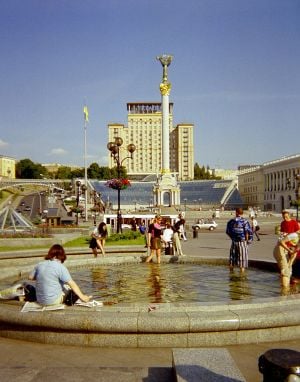
The industrial regions in the east and south-east are the most heavily populated. Significant migration took place in the first years of Ukrainian independence. In total, between 1991 and 2004, 2.2 million immigrated to Ukraine (two million from the other former Soviet Union states), and 2.5 million emigrated from Ukraine (among them, 1.9 million moved to former Soviet Union republics).
Low salaries and unemployment within Ukraine at the end of the 1990s meant that by 2007, approximately two to three million Ukrainian citizens were working abroad, many illegally, in construction, service, housekeeping, and agriculture industries. A significant number of Ukrainian women had been forced into prostitution and sex slavery in Western Europe and Turkey.
Ethnicity
Ethnic Ukrainians make up the majority of the population, while most of remainder are Russians with small numbers of Belarusians, Moldovans, Crimean Tatars, Bulgarians, Hungarians, Romanians, Poles, Jews, Armenians, Greeks, and Tatars.
Romanians and Moldavians are concentrated mainly in Chernivtsi, Odessa, Zakarpattia and Vinnytsia oblasts. Jews played an important role in Ukrainian cultural life in the nineteenth and first half of the twentieth century.
Religion
The dominant religion in Ukraine is Eastern Orthodox Christianity, which is split between three bodies: Ukrainian Orthodox Church (Moscow Patriarchate), Ukrainian Orthodox Church - Kiev Patriarchate, and Ukrainian Autocephalous Orthodox Church.
A distant second is the Eastern Rite Ukrainian Greek Catholic Church, which practices a similar liturgical and spiritual tradition as Eastern Orthodoxy, but is in communion with the See of Peter and recognizes the primacy of the Pope.
Protestant Christians form a small proportion of the population, although their numbers have increased since Ukrainian independence. The Evangelical Baptist Union of Ukraine is the largest group; other groups include Calvinists, Lutherans, Methodists, Seventh-day Adventists and others.
The Jewish community is a tiny fraction of what it was before World War II. Most Ukrainian Jews are Orthodox, and there is a small Reform population.
There are also a small number of Muslims, mostly on the Crimean Peninsula. Most Ukrainian Muslims are Crimean Tatars. In addition, foreign-born Muslims live in Kiev.
Language
Ukrainian is the only official language. It is an Indo-European language of the Eastern Slavic group, and uses the Cyrillic alphabet. Contemporary literary Ukrainian developed in the eighteenth century from the Poltava and Kiev dialects. Russian, which was a de facto official language in the Soviet Union, is widely spoken, especially in eastern and southern Ukraine.
It is sometimes difficult to determine the extent of the two languages, since many people use a Surzhyk (a mixture of Ukrainian and Russian where the vocabulary is often combined with Ukrainian grammar and pronunciation). The government seeks to increase the use of the Ukrainian language, generally at the expense of Russian, by requiring that the language is used in schools, government offices, and some media, even in areas which are largely Russian-speaking.
Yiddish, the Ukrainian Jews' traditional language, is only used by a small number of older people.
Men and women
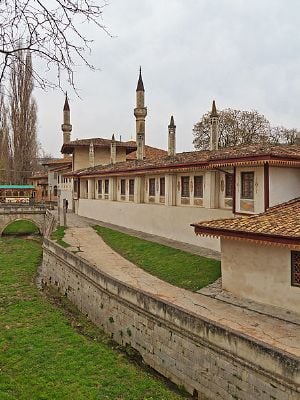
Although Ukrainian labor laws guarantee equal opportunity, few women have positions at higher levels of government and management, and numerous women work in manual and trade jobs. Teachers and nurses are mostly women, while school administrators and physicians are mostly men.
Marriage and the family
Most weddings have civil and religious ceremonies. A number of traditional customs may be followed:
- Before the wedding, the groom goes with his friends to the bride's house and bargains with "money' to get a bride from her family.
- When leaving the church, the bride carries a basket of candies or sweets to throw to children and the crowd
- The groom carries her down any stairs
- At the reception, the bride dances with each of the unmarried women present, and places a special veil on each of them. This veil symbolizes that they are still pure, but that the bride hopes they will get married soon. She also throws a bunch of flowers and the girl who catches it first will likely be the next to marry.
Chronic housing shortages have meant many young couples live with their parents in close quarters, often causing family strife. The Ukrainian Catholic Church prohibits divorce, while the Orthodox Church discourages it. Ukrainian inheritance customs mean sons and daughters inherit parents' property equally.
Paid maternity leave is available for up to one year and unpaid leave of up to three years. Grandparents often care for grandchildren, especially in lower-income families.
Education
Ukraine's educational system has produced a high literacy rate. Education is compulsory from the age of seven, while many children attend certain pre-school courses at age six.
The first level of postgraduate education is aspirantura that usually results in the Kandidat Nauk (Candidate of Sciences degree). The candidate should pass three exams (in his or her special field, in a foreign language of choice, and in philosophy), publish at least three scientific articles, write a dissertation and defend it. This degree is roughly equivalent to the Ph.D. in the United States.
Two to four years of study in doctorantura, publishing research and writing a new thesis would result in the Doctor Nauk degree (Doctor of Sciences), but the typical way is to work in a university or scientific institute while preparing a thesis. The average time between obtaining kandidat and doctor degrees is roughly ten years, and most new Doctors are 40 and more years old. Only one of four Kandidats reaches this grade.
The major universities are: the National Technical University of Ukraine, the National Taras Shevchenko University of Kiev, the Kharkiv Polytechnical Institute, Lviv University, Lviv Polytechnic, and Kharkiv University.
Class
Under the Soviet regime, the Communist Party elite enjoyed a preferential status in the officially classless society comprising workers, peasants, and working intelligentsia. After independence, numerous former Soviet bureaucrats either retained their status with the new administration, or became rich business professionals. Government-paid education, health care, and research professionals are in the lowest income bracket, and unemployment among blue-collar workers increased as heavy industry adjusted to new requirements. Anyone with cash can buy status symbols such as cars, houses, luxury items, and fashionable clothes.
Culture
Like most Western countries, Christianity has influenced Ukrainian customs, while Russian and other Eastern European cultures also have had a significant impact. Ukraine's culture has unique art, architecture, cuisine, dance, literature, music theater, and cinema, all shaped by various eras of domination by other nations, Soviet repression, and an on-going striving for national identity.
Architecture
Ukraine has remnants of sophisticated architecture of the Greek and Roman colonies in the Black Sea region. Slavic tribes built log houses in forested highlands and frame houses in the forest-steppe. Kievan Rus urban centers were built in a European-style, with a prince's fortified palace surrounded by town dwellers’ houses.
Stone was used in public buildings from the tenth century. Byzantine church architecture was combined with local features, to produce structures like the Saint Sophia Cathedral in Kiev (built about 1030), and the Holy Trinity Church over the Gate of the Pechersk Monastery (1106‚Äď1108). Romanesque half-columns and arches appear in Kievan Rus church architecture from the twelfth century, the Renaissance style appears in the Khotyn and Kamyanets'-Podil'skyi castles, built in the fourteenth century. An example of baroque wooden architecture, with richer ornamentation, is the eighteenth century Trinity Cathedral in former Samara, built for Zaporozhian Cossacks.
Seventeenth and eighteenth century villages used wood and wattled clay, and were centered around a church, community buildings, and marketplace, with streets following property lines and land contours. The empire architectural style came from the West, in the nineteenth and early twentieth centuries, bringing grid-pattern town layouts with promenades.
The Soviet period brought large plain government buildings and apartment blocks as seen throughout Soviet territories. But Ukrainians prefer single houses with a private space between the street and the house, usually with a garden. People living in apartment buildings partition long hallways into smaller private spaces. Dacha (summer cottage) cooperatives provide summer holiday homes for city dwellers.
Art
Kievan Rus art began with icons on wooden panels. Monumental mosaics embellished churches, along with frescoes on the interior walls and staircases. Kiev became a center of engraving in the seventeenth century. The Baroque era secularized Ukrainian painting, popularizing portraiture.
Mykola Pymonenko (1862‚Äď1912) organized a painting school in Kiev favoring a post-Romantic style. Nationalism pervaded paintings of Serhii Vasylkyvs'kyi (1854‚Äď1917), while Impressionism characterized work by Vasyl (1872‚Äď1935) and Fedir Krychevs'ky (1879‚Äď1947).
During the late 1920s and early 1930s, the Soviets began enforcing socialist realism, which required that all artists and writers glorify the Soviet regime. The muralist Alla Hors'ka (1929-1970), who rejected social realism, was assassinated, and the painter Opanas Zalyvakha (1925- ) was imprisoned in the gulag. After World War II, numerous Ukrainian artists emigrated into the United States and other Western countries. Jacques Hnizdovsky (1915‚Äď1985) achieved recognition in engraving and woodcuts, Mykhailo Chereshniovsky for stylized sculpture, as did caricaturist Edvard Kozak (1902‚Äď1998).
Cuisine
Bread is a core part of every meal. At Christmas time it is a tradition to have a 12-dish Christmas Eve supper. Also, kutia - a mixture of cooked buckwheat groats, poppy seeds, and honey, and special sweet breads - is prepared. Included at Easter are the famous Pysanky (colored and patterned eggs). Making these eggs, using wax and dye, is a long but fun process, and they are not eaten, but displayed in the centre of the table (usually around the bread).
Best-known foods are: Salo (salted pork fat with garlic), borscht (a vegetable-based soup, usually with beets and beef or pork), holobtsi (cabbage rolls stuffed with rice and meat), varenyky (stuffed dumplings), and pyrohy (a fried, dessert version of varenyky, filled with fruit instead of meat or cheese)
Ukrainians always toast to good health, linger over their meal, and engage in lively conversation with family and friends. Often they will drink tea (chai), wine, or coffee afterwards with a simple dessert, such as a fruit pastry.
Customs
Ukrainians carry themselves in a polite, civilized manner. Men often hold the door open for a woman when she enters a building, stand up when a woman enters the room, and, if there is a shortage of seats, men will give up their seats to the women. In rural areas, men will sometimes kiss a woman's hand, but this is starting to go out of fashion.
According to convention, when standing at a threshold (doorsill), Ukrainians do not shake hands or offer anything to be taken by the person on the other side. A young unmarried man or woman should not be seated at a table's corner. Ukrainians always buy an odd number of flowers as a gift, unless it is a funeral, when it is appropriate to buy an even number. Ukrainians do not hesitate to say: please (bud’ laska), thank you (dyakuyu), and you're welcome (proshu).
Dance
A Ukrainian style of dancing is called kalyna. Both men and women participate. Kalyna dancing involves partner dancing. In the slow and respectful previtanya, a greeting dance, the women bow to the audience and present bread with salt (symbolizing life and hospitality) on a cloth and flowers. The hopak is much more lively, and is derived from the hopak martial art of Cossacks.
- The women wear colorful costumes, sometimes featuring a blue, green, red, or black tunic and matching apron, an open skirt, and below that a white skirt with an embroidered hem. If they wear a tunic, over a long-sleeved richly embroidered white shirt. Women also wear red leather boots, a headband covered with flowers with long flowing ribbons down the back, and plain red coral necklaces.
- The men wear baggy pants (usually blue, white, black or red), and a shirt (usually white, but sometimes black) embroidered at the neck and down the stomach, a richly embroidered vest, around the waist a thick sash with fringed ends. Boots can be black, white or red.
Other traditional dances include: the kozak, kozachok, tropak, hrechanyky, kolomiyka and hutsulka, metelytsia, shumka, arkan, kateryna, and chabarashka. Popular dances from outside the Ukrainian ethnic region include: the polka, mazurka, krakowiak, cs√°rd√°s, waltz, kamarynska and barynya. Ukrainian instrumental and dance music has influenced Jewish and Gypsy music.
Literature
Ukrainian literature began with Kievan Rus chronicles. The original literature in was written in the Church Slavonic. Major works include the Tale of Bygone Years by Nestor the Chronicler, a twelfth century epic The tale of Igor's campaign. Printing presses were established in Lviv and Ostrih in 1573, where the Ostrih Bible was published in 1581. The sixteenth century included the folk epics called dumy, which celebrated the activities of the Cossacks.
The father of Ukrainian literature is Ivan Kotlyarevsky, who wrote a mock epic of Virgil's Aeneid (1798) that turns Virgil's characters into Ukrainian Cossacks. Its language was based on the spoken Ukrainian of the Poltava region.
In 1837, three writers‚ÄĒMarkiian Shashkevych (1811‚Äď1843), Ivan Vahylevych (1811‚Äď1866) and Yakiv Holovats'kyi (1814‚Äď1888)‚ÄĒpublished a literary collection under the title The Nymph of Dnister, which focused on folklore and history and began to unify the Ukrainian literary language. The 1840 collection of poems entitled Kobzar, by Taras Shevchenko (1814‚Äď1861), became symbols of Ukrainian national identity. Panteleimon Kulish (1819‚Äď1897), Marko Vovchok (1834‚Äď1907), Ivan Nechuj-Levyts'kyj (1838‚Äď1918), Panas Myrnyj (1849‚Äď1920), and Borys Hrinchenko (1863‚Äď1910) developed realistic novels and short stories in the late nineteenth century.
After the Soviet takeover, numerous Ukrainian writers emigrated. A group known as the Free Academy of Proletarian Literature (1925‚Äď1928) included the poets Pavlo Tychyna (1891‚Äď1967) and Mike Johansen (1895‚Äď1937), the novelists Yurij Yanovs'kyi (1902‚Äď1954) and Valerian Pidmohyl'nyi (1901‚Äď1937?), and the dramatist Mykola Kulish (1892‚Äď1937). The leader of this group, Mykola Khvyliovyi (1893‚Äď1933), advocated an orientation towards Europe and the group championed national interests within a Communist ideology. Khvyliovyi killed himself after witnessing the 1933 famine, and most members were arrested and killed in Stalin's prisons.
Socialist realism, from the 1930s to the 1960s, required writers to champion government policies, leading to opposition from a new generation of writers, from 1960 to 1970, including novelist Oles' Honchar (1918‚Äď1995), as well as poets Lina Kostenko (1930‚Äď ), Vasyl' Stus (1938‚Äď1985),and Ihor Kalynets' (1938‚Äď ).
Music
Ukrainian folk music includes solo singing, including holosinnya sung at wakes, and there are professional itinerant singers known as kobzari. Lyric historical folk epics known as dumy are sung to the accompaniment of the bandura, kobza (lute) or lira. There is an archaic type of modal "a cappella" vocal singing in which a phrase sung by a soloist is answered by a choral phrase in two- or three- voice harmony. Ukrainian folk songs are based on minor keys.
Other common traditional instruments include: the torban (bass lute), violin], basolya (three-string cello), the lyra (hurdy-gurdy) and the tsymbaly; the sopilka (duct flute), floyara (open, end-blown flute), trembita (alpenhorn), fife, koza (bagpipes); and the buben (frame drum), tulumbas (kettledrum), resheto (tambourine) and drymba (jaw harp). Traditional instrumental ensembles are often known as tro√Įst√Į muzyki ("three musicians"). Instrumental performance usually includes improvisation.
Ukraine has produced classical composer Franz Xaver Wolfgang Mozart, performers Vladimir Horowitz, David Oistrakh, Sviatoslav Richter, and avant-garde composers Baley, Silvestrov, and Hrabovsky. There are also musicians (Kostyantyn Chechenya, Wolodymyr Smishkewych, Vadym Borysenko and Roman Turovsky who have been preserving Ukrainian music of the Medieval, Renaissance and Baroque eras.
Theater and cinema
Ukrainian theater developed from folk shows, known as vertep. Sentimentalist plays were presented during the eighteenth-century, and a permanent Ukrainian theater was established in 1864 by the Ruthenian Club in Lviv. Marko Kropyvnyts'kyi (1840‚Äď1910), Mykhailo Staryts'kyi (1840‚Äď1904), Ivan Karpenko-Karyi (1845‚Äď1907), the actors and directors Panas Saksahans'kyi (1859‚Äď1940), and Mykola Sadovs'kyi (1856‚Äď1933), created historical and social plays. Sadovs'kyi's productions were filmed, marking the beginning of Ukrainian cinema in 1910.
From 1917 to 1922 numerous theaters appeared in Ukraine, the most prominent new figure being Les' Kurbas, the director of The Young Theatre in Kiev. The expressionist style was adopted by film director Oleksandr Dovzhenko (1894‚Äď1956), whose first notable movie was the 1926 silent movie Love's Berries. Dramatist Mykola Kulish (1892‚Äď1937) dealt with social and national conflicts in Soviet Ukraine. In 1933‚Äď1934 Kurbas, Kulish, and numerous actors were arrested and later killed in Stalin's prisons. Socialist realism became the approved drama style, and party hack Oleksander Korniichuk the main dramatist.
After World War II, Ukrainian actors in refugee camps in Western Europe used theater to preserve national culture. Volodymyr Blavats'kyi (1900‚Äď1953) and Josyp Hirniak continued to perform in professional companies in New York into the 1950s and 1960s.
In cinema of the 1960s, director Kira Muratova utilized existentialist concepts. The impressionistic Shadows of Forgotten Ancestors (1964) by Sergij Paradzhanov and Jurii Ilienko won a prize at Cannes. One of the largest film production studios in Ukraine is the Olexandr Dovzhenko Film Studios, located in Kiev. One major Ukrainian distributor is Cinergia, the local distributor of films by Warner Bros., New Line Cinema and Miramax Films.
Sports
Of the numerous different sports played in Ukraine, the most popular is football (soccer), in which there are five levels. The strongest and most popular league is the Ukrainian Premier League, followed by the Ukrainian First League, the Druha Liha A, Druha Liha B, and Druha Liha C. Clubs are promoted or demoted between leagues according to points scored. The teams from all leagues can participate in the Ukrainian Cup. The winners of the Ukrainian championship and the Ukrainian Cup take part in the Ukrainian Super Cup. Ukraine won a joint bid with Poland to host the 2012 UEFA European Football Championship which is the third largest sporting event in the world after the Olympics and the World Cup.
Ukraine has an ice hockey league, and a national ice hockey team. The nation also has a relatively unknown basketball league, although the teams are strong enough to make it into the Eurocup basketball championship. There are numerous cricket clubs. Ukraine is a regular participant in the Olympic Games, both summer and winter.
Notes
- ‚ÜĎ 1.0 1.1 All-Ukrainian population census, 2001: National composition of population Ukrainian Office of Statistics. Retrieved March 17, 2022.
- ‚ÜĎ Ukraine Population Worldometer. Retrieved March 17, 2022.
- ‚ÜĎ 3.0 3.1 3.2 3.3 World Economic Outlook (October 2021): Ukraine International Monetary Fund. Retrieved March 17, 2022.
- ‚ÜĎ GINI index (World Bank estimate) - Ukraine The World Bank. Retrieved March 17, 2022.
ReferencesISBN links support NWE through referral fees
- Chirovsky, Nicholas L. Nineteenth and Twentieth Century Ukraine. New York: Philosophical Library, 1986. ISBN 0802224814
- Kuzio, Taras. Contemporary Ukraine Dynamics of Post-Soviet Transformation. Armonk, NY: M.E. Sharpe, 1998. ISBN 0585019894
- Conquest, Robert. The Harvest of Sorrow: Soviet collectivization and the terror-famine. London: Pimlico, 2002. ISBN 0712697500
- Magocsi, Paul R. A History of Ukraine. Seattle: University of Washington Press, 1996. ISBN 0295975806
- Wilson, Andrew. Ukrainian Nationalism in the 1990s: A minority faith. Cambridge [Eng.]: Cambridge University Press, 1996. ISBN 0521482852
- Shcherbak, IÔł†UÔł°riń≠. Chernobyl: A documentary story. New York: St. Martin's Press, 1989. ISBN 0312030975
- Wanner, Catherine. Burden of Dreams: History and Identity in Post-Soviet Ukraine . University Park, PA: Pennsylvania State University Press, 1998. ISBN 0271017929
External links
All links retrieved May 2, 2023.
- CIA World Factbook. Ukraine.
- Countries and Their Cultures. Ukraine.
- U.S. Department of State. Ukraine.
- BBC. Ukraine country profile.
Credits
New World Encyclopedia writers and editors rewrote and completed the Wikipedia article in accordance with New World Encyclopedia standards. This article abides by terms of the Creative Commons CC-by-sa 3.0 License (CC-by-sa), which may be used and disseminated with proper attribution. Credit is due under the terms of this license that can reference both the New World Encyclopedia contributors and the selfless volunteer contributors of the Wikimedia Foundation. To cite this article click here for a list of acceptable citing formats.The history of earlier contributions by wikipedians is accessible to researchers here:
- Ukraine  history
- Name_of_Ukraine  history
- Geography_of_Ukraine  history
- Kiev  history
- Dnieper_River  history
- History_of_Ukraine  history
- History_of_the_Cossacks  history
- Ukraine_after_the_Russian_Revolution  history
- Chernobyl_disaster  history
- Government_of_Ukraine  history
- Foreign_relations_of_Ukraine  history
- Economy_of_Ukraine  history
- Demographics_of_Ukraine  history
- Education_in_Ukraine  history
- Kiev_Polytechnic_Institute  history
- Culture_of_Ukraine  history
The history of this article since it was imported to New World Encyclopedia:
Note: Some restrictions may apply to use of individual images which are separately licensed.


